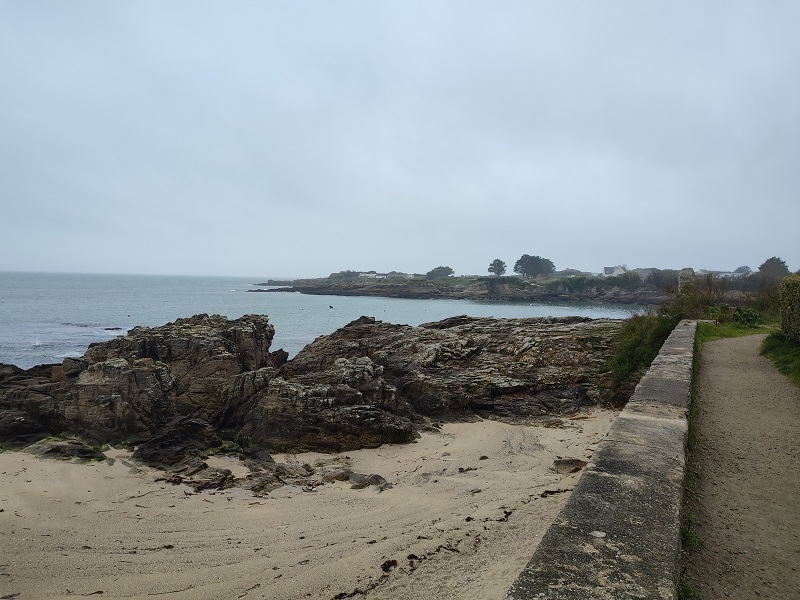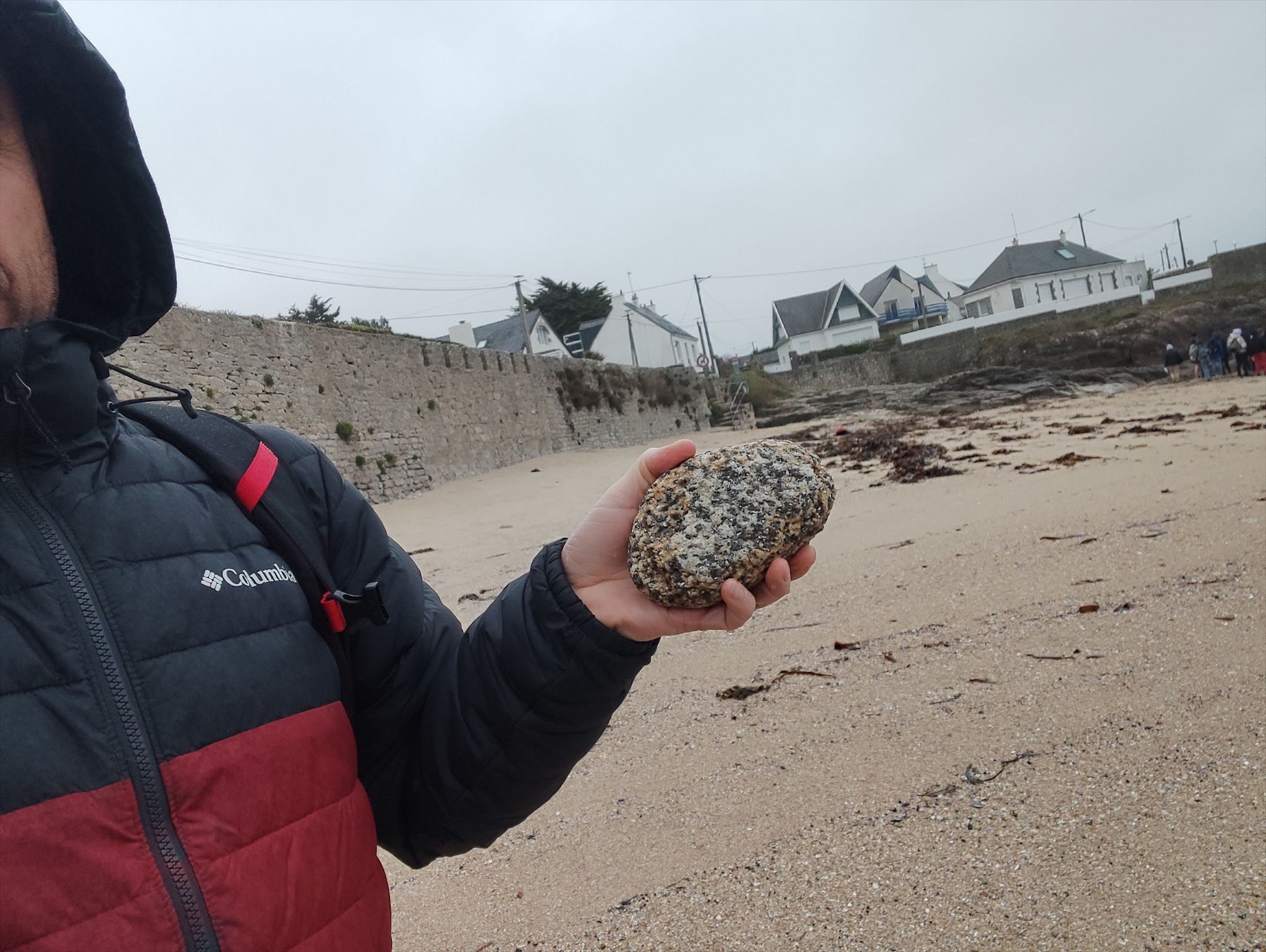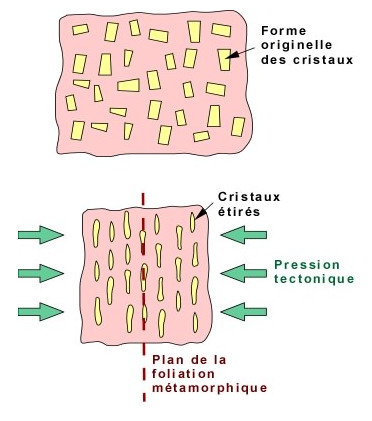Le granite dans tous ses états.

Selon WIKIPEDIA :
Le granite est une roche plutonique à texture grenue, riche en quartz, qui comporte plus de feldspath alcalin que de plagioclase. Il est caractérisé par sa constitution en minéraux : quartz, feldspaths potassiques (orthoses) et plagioclases, micas (biotite ou muscovite)
La granita est un entremets glacé italien typiquement sicilien. Elle est considérée comme la mère de toutes les glaces, du sorbet à la crème glacée. Il s’agit d’un liquide semi-congelé à base d'eau, de sucre, originellement de citron et jus de citron de Sicile, mais qui se décline aujourd'hui à l'orange, à l'amande, ou à la pistache de Bronte par exemple.
Vous êtes ici pour étudier l'un des deux, mais pas le plus rafraishissant !

(image provenant de http://avg85.fr/wp-content/uploads/2014/03/2013.03.AVG-TP-min%C3%A9ralogie.Diaporama-3.pdf)
1) A l'échelle d'affleurement (comme sur la photo précédente) :
Quels mots utiliseriez vous pour décrire le granite : massif, en feuillet, cassures, bloc, blanc, beige, marron.
Peut on voir les cristaux qui composent le granite ?
2) Passons à l'échelle de l'échantillon. Ramasser un échantillon en bord de plage comme la photo ci-dessous (il y en a beaucoup):

a) Poster avec votre log, une photo de vous avec l'échantillon (le visage n'est pas obligatoire)
b) Analyser les cristaux de l'échantillon :
- Quelles couleurs voyez vous ? Quelle est la couleur dominante ?
- L'échantillon est il entièrement cristallisé ou y a t il une partie sans cristaux ?
- Les cristaux sont ils orientés (image du bas) ? ou non orientés (image du haut) ?

(image : http://www2.ggl.ulaval.ca/personnel/bourque/s2/r.metam.html)
3) Une explication de ce que vous avez vu, avec le cours de https://coursgeologie.com/
A partir d'un même magma, la texture (présence ou non de minéraux visibles a l'oeil nu) de la roche obtenue dépend de la vitesse de refroidissement. Plus le refroidissement sera lent, plus les minéraux vont croître. Si, en revanche, la vitesse de refroidissement est importante, les minéraux n'ont pas le temps de se former, ils vont être microscopiques. Si la vitesse de refroidissement est extrême (lors de la rencontre d'un magma et de l'eau), aucun minéral cristallin n'apparaît, et la roche prend une structure dite "vitreuse" (ex: obsidienne). C'est le phénomène de trempe.
On va ainsi distinguer :
les roches à texture grenue où tous les minéraux sont visibles à l'oeil nu et ont une taille millimétrique,
les roches à texture microgrenue, où l'on observe quelques minéraux visibles à l'oeil nu mais l'essentiel de la roche est formée de minéraux parfaitement visibles au microscope.
les roches à texture vitreuse, où il y a quelques cristaux mais l'essentiel de la roche est formé d'un verre (structure non ordonnée des atomes à la différence des cristaux).
De quoi dépend la vitesse de refroidissement d'un magma? du contraste de température entre le magma et son encaissant (ce qu'il y a autour). Cela dépend donc de l'endroit où cristallise le magma.
Si le magma refroidit en profondeur (où la température ambiante est assez élevée), le refroidissement va être lent, les minéraux vont croître. La roche obtenue sera une roche magmatique "plutonique" avec une texture grenue.
Si le magma arrive en surface ou très proche de la surface, son refroidissement est beaucoup plus rapide car la température ambiante est plus faible. La roche obtenue sera une roche magmatique "volcanique", dont la texture sera en générale microgrenue ou vitreuse.
A vous de conclure :
a) Le granite que vous avez sous les yeux est grenue ? microgrenue ? vitreux ?
b) il a été crée en profondeur ? proche de la surface ?
c) c'est une roche magmatique plutonique ou volcanique ?
Loguez cette cache "Found it" et envoyez-moi vos propositions de réponses soit via mon profil, soit via la messagerie geocaching.com (Message Center), et je vous contacterai en cas de problème.
ENGLISH VERSION
According to WIKIPEDIA:
Granite is a grainy-textured, quartz-rich plutonic rock that contains more alkaline feldspar than plagioclase. It is characterized by its mineral constitution: quartz, potassium feldspars (orthoclases) and plagioclases, micas (biotite or muscovite)
Granita is a typically Sicilian Italian frozen dessert. It is considered the mother of all ice cream, from sorbet to ice cream. It is a semi-frozen liquid based on water, sugar, originally lemon and lemon juice from Sicily, but which is now available in orange, almond, or pistachio from Bronte for example.
You are here to study one of the two, but not the most refreshing!
1) At flush scale (as in the photo):
What words would you use to describe granite: solid, sheet, fracture, block, white, beige, brown.
Can we see the crystals that make up the granite?
2) Let's go to the sample scale. Pick up a beachside sample like the photo (there are a lot of them):
a) Post with your log, a photo of you with the sample (face is not required)
b) Analyze the crystals of the sample:
- What colors do you see? What is the dominant color?
- Is the sample completely crystallized or is there a part without crystals?
- Are the crystals oriented (bottom image)? or not oriented (top image)?
3) An explanation of what you saw, with the course from https://coursgeologie.com/
From the same magma, the texture (presence or absence of minerals visible to the naked eye) of the rock obtained depends on the cooling rate. The slower the cooling, the more the minerals will grow. If, on the other hand, the cooling rate is high, the minerals do not have time to form, they will be microscopic. If the cooling rate is extreme (when magma and water meet), no crystalline mineral appears, and the rock takes on a so-called "vitreous" structure (ex: obsidian). This is the quenching phenomenon.
We will thus distinguish:
grainy-textured rocks where all the minerals are visible to the naked eye and are millimeter in size,
rocks with a micrograin texture, where there are some minerals visible to the naked eye but the bulk of the rock is made up of minerals perfectly visible under a microscope.
vitreous-textured rocks, where there are some crystals but most of the rock is made of glass (unordered structure of atoms unlike crystals).
What does the cooling rate of a magma depend on? the temperature contrast between the magma and its surrounding (what is around). It therefore depends on where the magma crystallizes.
If the magma cools at depth (where the ambient temperature is high enough), the cooling will be slow, the minerals will grow. The rock obtained will be a "plutonic" igneous rock with a grainy texture.
If the magma arrives at the surface or very close to the surface, its cooling is much faster because the ambient temperature is lower. The rock obtained will be a "volcanic" magmatic rock, the texture of which will generally be micrograined or vitreous.
It's up to you to conclude:
a) Is the granite in front of you grainy? micrograin? vitreous?
b) it was created in depth? close to the surface?
c) is it a plutonic or volcanic igneous rock?
Log this "Found it" cache and send me your proposed answers either via my profile or via geocaching.com messaging (Message Center), and I will contact you if there is a problem.